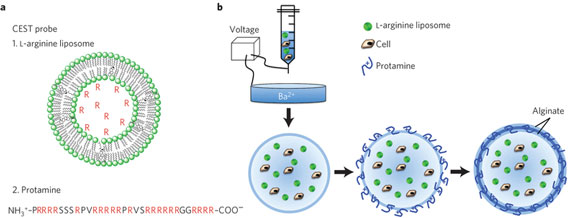| Feb 08, 2013 |
Nanotechnology checks on transplanted cell survival
|
|
(Nanowerk News) Researchers at Johns Hopkins are using nanotechnology to track the survival and location of transplanted cells. The device, based on nanoscale ph sensors and imaging via magnetic resonance, could help improve outcomes from cell replacement therapies used for conditions such as liver disease or type 1 diabetes.
|
 |
| Cartoon showing nanoscale probe used to detect pH change caused by death of transplanted cell. a, The L-arginine (R) moieties (red) entrapped in liposomes (1) and in protamine (2) have exchangeable protons that provide CEST contrast. b, A mixture of cells, alginate and L-arginine liposomes is passed through a needle using a nanoinjector pump. The single-layered charged alginate droplets are collected, washed and resuspended in a crosslinker solution (protamine sulphate), followed by a coating with a second layer of alginate.
|
|
“This technology has the potential to turn the human body into less of a black box and tell us if transplanted cells are still alive,” says Mike McMahon, Ph.D., an associate professor of radiology at the Johns Hopkins University School of Medicine principal investigator on the study. “That information will be invaluable in fine-tuning therapies.”
|
|
Transplanted cells often fall victim to assault from the body’s immune system, which sees the news cells as foreign invaders. Says McMahon, ”once you put the cells in, you really have no idea how long they survive.”
|
|
When cells die there is a change in the acidity nearby. Using this fact, the researchers developed a nanoparticle sensor that could both sense the change in pH and be detected via MRI. The team tested the sensors on mice and found they they were able to track the location of surviving transplanted cells and determine the proportion that had survived.
|
|
“It was exciting to see that this works so well in a living body,” says research fellow Kannie Chan, Ph.D., the lead author on the study, which was published in Nature Materials ("MRI-detectable pH nanosensors incorporated into hydrogels for in vivo sensing of transplanted-cell viability"). This should take a lot of the guesswork out of cell transplantation by letting doctors see whether the cells survive, and if not, when they die,” Chan says. “That way they may be able to figure out what’s killing the cells, and how to prevent it.”
|

